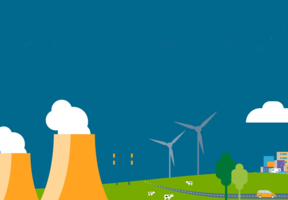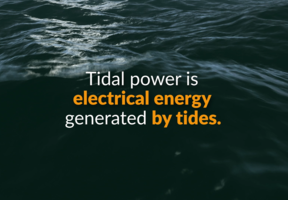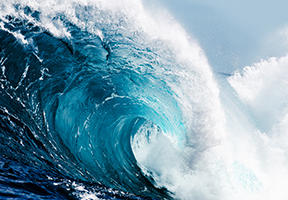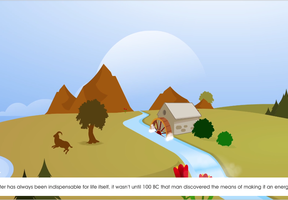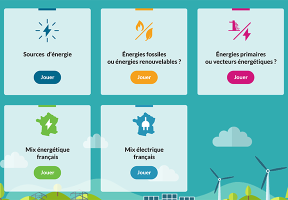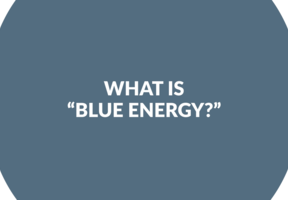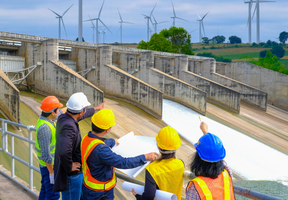How It Works: Ocean Energy
5 min read
Wind, waves, currents and tides are powerful forces that agitate the seas and oceans, which make up 70% of the Earth’s surface. They contain vast potential. Here is an overview of the current technologies.
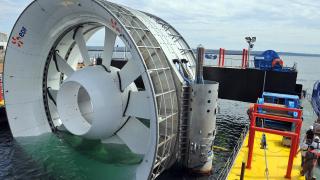
© FRED TANNEAU / AFP - A tidal turbine is tested in Brest before being installed: one of the most advanced marine technologies.
Sometimes called “blue energy”, ocean energy encompasses the different technologies that are used to produce energy – usually – from various marine resources:
- Wind blowing over the sea ( wind).
- Tides (tidal energy).
- Currents (ocean current energy).
- Waves and swells (wave energy).
- Temperature differences between surface and deeper water (ocean thermal).
- Salinity gradient at river mouths (osmotic energy).
- Microalgae
(
).
These technologies differ from traditional hydro facilities, i.e., hydropower plants that produce power from falling water or run-of-the-river plants that harness the flow of streams or rivers. Hydropower has been around since ancient times and is today by far the leading renewable energy source for generating electricity.
Offshore Wind
Offshore wind technology takes advantage of wind blowing on the high seas. As with an turbine, wind turns the blades of a rotor, and a generator converts the into electrical power.
At sea, winds are steadier, stronger and more frequent than on land. Offshore turbines are also much larger in size: the latest test models were 260 meters tall.
The offshore turbine is either anchored to the seabed at a technically limited maximum water depth of 50 meters (fixed-bottom turbine) or attached to a floating structure (floating turbine) in deeper waters (up to 300 meters).
Tidal Energy
Tidal energy is based on the surge of enormous amounts of water as ocean tides rise and fall. Like conventional hydroelectric dams, tidal barrages built on estuaries hold back huge amounts of water twice a day. When the water is released, it drives turbines to produce electricity via a generator.
Ocean Current Energy
Ocean current energy harnesses the kinetic energy of water currents using small tidal turbines. The turbines are either tethered in arrays to the seabed or float in mid-water.
Because water has a higher density than air, tidal turbines are much smaller than their wind counterparts (10 to 20 meters in diameter).
Wave Energy
At sea, the force of waves and swells is considerable and omnipresent. It can drive mechanical systems to generate electricity.
Different techniques for harnessing the force of waves are currently being tested: floating hinged caissons that drive pistons, submerged or onshore oscillating water columns and tapered channel systems, i.e., shore-mounted structures that channel waves to a reservoir above sea level that gradually fills and empties.
Ocean Thermal
The ocean is a vast storehouse for
energy. In intertropical regions, the difference between the surface waters (22°C and above) and the deep waters (2-4°C at 1,000 meters) can be leveraged to produce energy, provided that the temperature differential is at least 20°C. The temperature gradient is used to vaporize a fluid, which then turns a turbine generator as the steam expands.
Osmotic Energy
Located at river mouths, plants use a semi-permeable membrane to exploit the movement of water caused by the different salt concentrations of freshwater and seawater. The membrane lets the water through but not the dissolved salt, a process called osmosis. The flow of water causes a build-up in pressure that can be used to spin turbines and generate power.
Microalgae Biomass
Microalgae biomass can be used as a source of energy, in the form of oil, to produce biofuels. Around 300 species have been identified as having the ability to produce large quantities of oil. Thanks to biotechnology, it’s possible to increase the industrial potential of microalgae and turn them into little “factories”, with per-hectare yields 20 to 30 times greater than those of terrestrial plant species – and without having to compete for farmland.


